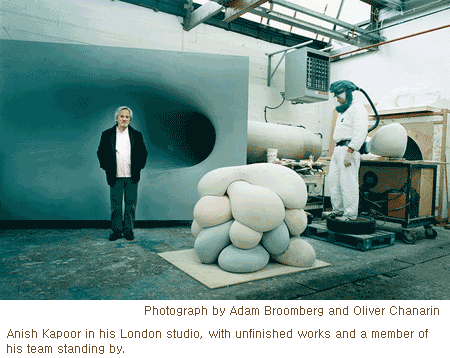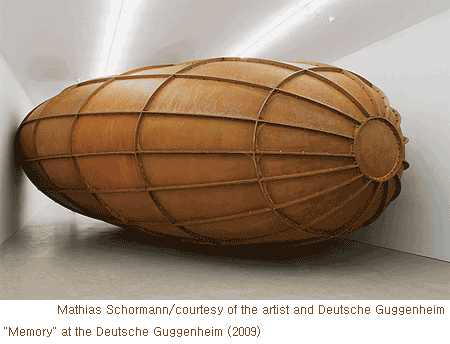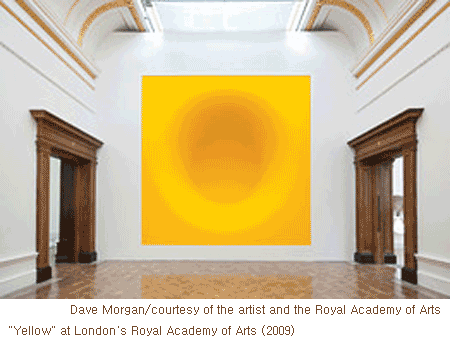Anish in ParisAnish Kapoor has always thought big. But with a breakthrough installation set to debut this month at the Grand Palais, London's leading artist is going colossal

For someone who by his own admission is in the midst of completing one of the "greatest challenges" of his career, Anish Kapoor is remarkably calm and collected. He wanders through his labyrinthine South London studio—the same one he has inhabited for 24 years—stopping to inspect assistants and technicians at work on various large-scale installations. There's a team of men in white overalls and masks carving into a block of polystyrene. Elsewhere, Kapoor pauses to discuss the intricacies of building the 380-foot, bloodred spiraling steel tower that will be the centerpiece of next year's British Olympic Games. It's only when he walks into the studio's innermost sanctum, where he works alone, that Kapoor's chatty confidence shows a crack. Standing in front of a model of Paris's Grand Palais and the upcoming site of his most massive construction to date, he says, "I'm not a guy who's afraid of big—I love big—but this is big in so many ways."
The French Ministry of Culture and Communication has asked the Indian-born, British-based artist to create a temporary, site-specific installation inside the nave of the Grand Palais, a glass-domed hall unveiled at the 1900 Universal Exhibition. In this, he is following in the footsteps of Richard Serra and Anselm Kiefer, who transformed the structure in previous years.

There is monumental. And there is "Monumenta," as the series is called. Kapoor intends to erect four giant PVC orbs that, when inflated, will fill the height, length and width of the 145,000-square-foot hall. The piece will be a major departure for the artist, who works almost exclusively with solid, predominantly metal, constructions.
At 57, Kapoor is one of the greatest artists of his generation. Not only is he consistently bankable, with works that earn up to $4 million at auction and a roster of blue-chip collectors, he's also a major draw with museumgoers. His bio includes stops at the Louvre, the Guggenheim and the Museum of Modern Art. In 2002, he filled the Tate Modern's colossal Turbine Hall with "Marsyas," a trumpet-shaped installation that attracted a staggering 1.85 million viewers, making it the single most popular exhibition that museum has ever held. And when the Royal Academy staged a retrospective of Kapoor's work in 2009, 275,000 people visited the show. To date, it remains the most successful exhibition by a living artist at the RA. "His work, which is abstract, conceptual and spiritual, can be translated across cultures," explains Barbara Gladstone, his New York gallerist of more than 25 years. It's also playfully engaging, nudging the viewers to step inside a strange, shiny space or sneak under a hulking, floating orb, as with Kapoor's "Cloud Gate," a 110-ton "jellybean" that resides in Chicago's Millennium Park.

Just as his art has a cathartic optimism, Kapoor is so boyishly charming in person that it's almost disarming. Chalk it up to his youthful mop of hair; a tendency to punctuate most sentences with a wide grin or a throaty laugh; his happy home life, which revolves around his art historian wife, Susanne, and their two teenage children, Alba and Ishan; or a balanced perspective on things that comes from daily meditation.
Each morning, after having breakfast with his family at their West London town house, so sleek in its design as to resemble a gallery, he hops into his car and drives to his studio. There, he's aided by a team of 15 assistants, computer technicians and engineers. Yet for all the complex building blocks, Kapoor begins each new project with a simple plywood model. Hovering over his rendering of the Grand Palais, which is about the size of a wine case, he explains his concept for "Monumenta": "In its most basic form, it's a giant balloon. From the inside it's an involuted form that I can only describe as being quite bodily once you are inside. But when you travel outside of it, once you are back in the space of the Grand Palais, I hope then the viewer has another encounter with the form and with the luminosity thrown down by the glass roof."
The six-week-long installation will be a homecoming of sorts for Kapoor. It marks the 31st anniversary of his first exhibit in Paris. That show was held at a studio owned by the artist Patrice Alexandre, and although it was only advertised through word of mouth, Kapoor still recalls with pride how his pigment-powdered abstract sculptures inspired by travels to India nearly sold out. When asked how it feels to return to the City of Light under much different circumstances, Kapoor looks down. "Oh, much the same," he says, smiling modestly. "You see, the thing is, what's success really when it comes to art? A nice table in a restaurant? A better seat on a plane? People being nice to you in front of your face? I've learned a lot of lessons over the years and I admit I've been ambitious, but I have to say the real lesson I have gleaned, the one that matters to me, is this." He gestures around his studio. "You can be as well known as you want; you get the awards, the acclaim. But if it's not happening here, within the studio, with the work, then that's that. Here is where it begins and ends. You have to remember that. Art is only what you create."


